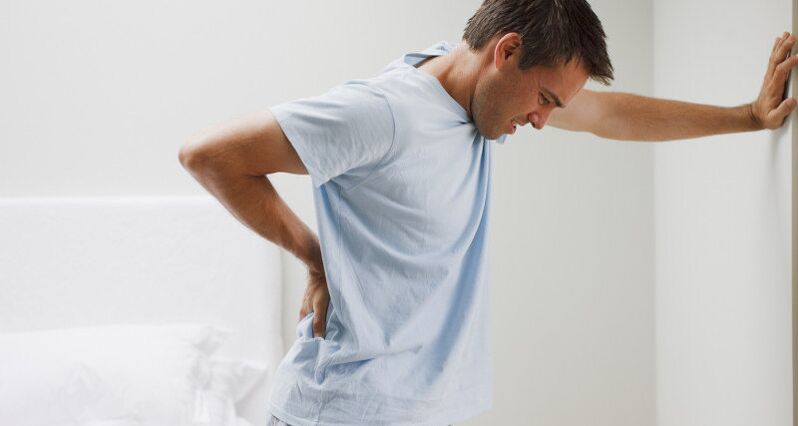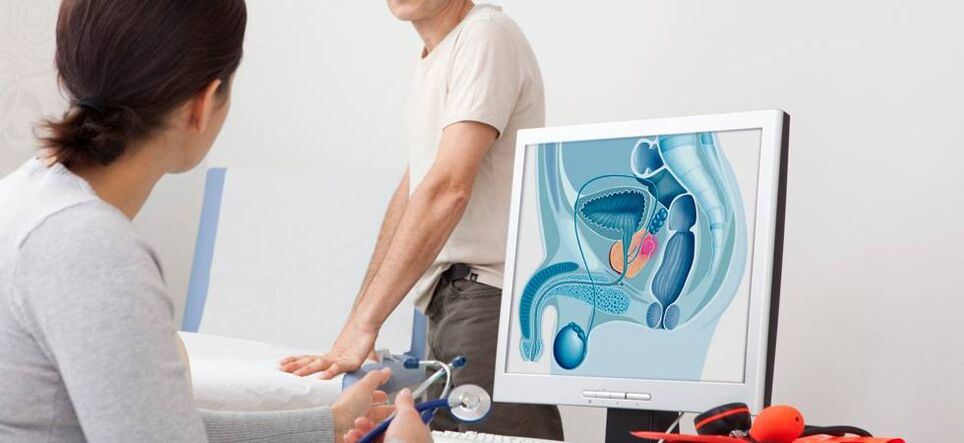The pathology of the prostate gland, which develops due to the inflammatory process in it, is called disease - prostatitis.
The development of pathology
More often than others, a form of infectious prostatitis occurs. Infections that can impress the prostate by penetrating the uretral hole or organs and other glands of the genitourinary system.
The probability of high organ infection is due to localization next to the anus and uretral tract.
With this possibility, statistics detect inflammation of the prostate in men, which are associated with organ fitness to infected neighbors.
Even the presence of infection in the prostate does not ensure the development of inflammation.
Prostate inflammation occurs with the joint action of pathogenic microorganisms and provocative factors.
The cause of prostatitis
Every man, who is shocked or understanding the disease is inevitable due to the hunting of provocative factors, can guess about prostatitis.

The prostate gland is a place for the transit of the uretral tract, therefore, the process of inflammation in the diseased organs, leading to an increase in its structure, leading to infarction of the bladder.
When creating a diagnosis for various forms of inflammation of the prostate gland, binary integers are used:
- Chronic is not up to date
- Chronically contagious
- Acute contagious
- Acute not acute
Varies of prostatitis are caused by complex factors that provoke certain circumstances.
The first factor statistically occurring in young and pre -etirement men - an infection that is transmitted from a sexual partner.
Venus disease, especially at the stage of symptom remission, can leave an infection in a hidden condition or prostate lesion, which is progressive even after the removal of infectious agents.
Infections can increase infection, excessive systematic eating, acute carbohydrate diet, excess oily, calorie.
This is how endless prostatitis occurs and the journey of various types of endless kinds is enhanced.
Provocation factors are hypothermia and age -related changes in the prostate.
A sign of prostatitis in men
It is difficult to diagnose a form of infectious or non -sweaty prostate inflammation, based solely on symptom equations.
If the following signs of prostatitis are detected, it is necessary to conduct a comprehensive diagnosis of the disease to detect the disease:
- While emptying the bladder, pain and experienced intensity, after the end of the urine, the patient feels the burning sensation in the urethra;
- body temperature exceeds normal;
- The feeling of emptying the bladder is incomplete after the end of the urine does not leave the sick man for some time;
- Pain in the period between urine is felt in the perineum, inguinal and stomach zones, which is reflected in the feet, buttocks, pelvis and sacrum;
- Lethargy and Malaise.
A man can form a suspicion of prostatitis if at least two of them become significant from the entire list and symptoms.
The specific sign of the inflammatory process in the prostate is the difference in temperature measured in different parts of the body.
Temperature change patterns are associated with localization of inflammation: The closer to it, the higher the temperature.
When measuring the temperature in the oral cavity, the deviation from the norm is not complied with, in the armpit - the subfebrile temperature, in the rectum the parameter value exceeds the norm greater than the level.
Symptoms of pain develop with increased intensity as inflammation increases in the prostate.
The common occurrence of pain is a feature of the process of clearing the bladder, during the day the pain extends to the rectum and the entire perineum area.
The intensity of the pain increases small to unbearable.
Cleaners and malaise can be accompanied by dizziness and headache, small nausea, drowsiness.
If such symptoms are detected, the delay in the urine is suspected, as a result of the general intoxication of the body developing a product of protein damage.

Degree in urination is associated with jet fatigue, long discharge of urine, will not form the jet and call to clear the bladder without the absence of urine.
The possibility of complications
Complications after prostatitis occur without medical intervention during the disease or incorrectly compile the treatment regimen.
Medical practice shows the most frequent distribution after prostatitis:
- lack of erection and ejaculation;
- dissemination of inflammation to organs near the genitourinary system;
- Cytological disorders leading to sperm inability to nourish eggs;
- declining libido;
- Psychoneurotic states that reducing the quality of life and health of a man as a whole.
After prostatitis, the penis sharply reduces the ability to harden and is filled with blood. The possibility of sexual relations ends rapidly compared to this new sex life. Not all sexual relations end with ejaculation.
If such deviations are detected, a comprehensive diagnostic test is required.
With the spread of inflammation to the urethra and bladder, cystitis and uretritis develop.
With the last development, painful pain appears, the process of urine outflow (delay or incontinence) threatens to switch to a chronic level. The performance of a man in the country is doubtful.
Erectile dysfunction leaves some psychological and therapeutic problems that require competent medical correction.
The body's disadvantage -the cave that will be filled with blood is explained by the state of edematous prostate and the related genitourinary organs.
The blood supply to the penis, which is needed for upright conditions, is a problem.
Psychologically, the third part of the male developed by the consequences after prostatitis suffered in severe form.
A man's condition can normalize only during long psychological work with the patient against the background of drug therapy. Failure in sexual life prevents further desire to continue sexual life.
Prostatitis can trigger a violation of sperm acid composition, which is reflected in sperm capacity.
The result of pathology is infertility in a man first. It is important in this situation to eliminate timely infertility due to the lack of chances of cure the second stage infertility with the drug method. Proper treatment can be prescribed by andrologist or urology. That's why men can't ignore the signs of prostatitis.
Diagnostics
The diagnostic examination scheme directly depends on the complaints and signs by which the patient deals with urologists or andrologists.
Diagnosis of prostatitis in men can be done at home and in medical institutions.
The initial diagnostic level is the collection of data for anamnesis. The doctor performed an external examination of the genitals and heard the patient's complaints.
Based on preliminary data, further diagnostic study schemes on a sick person are prescribed.
During the accumulation of anamnesis, doctors found the duration of the symptoms, the presence of prostatitis previously indicated, a list of diseases by the patient, the risk factors for the development of the disease, the possibility of sexually transmitted diseases, the development of the disease signs, the presence of sexual partners and sexual relations.
At the current stage of medical development, the list of questions was published in the questionnaire, which the patient filled out before a visit to the doctor's office. Therefore, the time the patient and the doctor are saved.
The first mandatory examination of patients with signs of prostatitis is the study of the prostate gland from the rectum.
Doctors determine the level of improvement in inflamed organs, its density, uniformity of consistency or presence of nodes, or seals, levels of pain during palpation.
Before palpation, the intestinal cavity is performed.
In the absence of inflammation in the prostate, there is no pain, with prostatitis, the intensity of the pain can vary, and their localization is felt in the thighs, rectum, perineum, and sacrum. In this case, it is contraindicated in several procedures, for example, cystography.
For microscopic examination of the prostate gland secretion, the patient is performed by the prostate massage through the rectum.
With the urge to urinate until the end of the prostate massage, this cannot be done until a drop of prostate secretion from the uretral opening is taken for analysis.
This procedure ends in running a microscope subject along the urethra hole, after which smear is painted and microscopic analysis according to the following parameters:
- presence of leukocytes and calculation of their quantity;
- quantity of lecitin;
- The activity of pathogenic microorganisms and their presence.

Bacterial detection in the field of smear view shows the type of infectious prostatitis.
The number of leukocytes in the field of view more than 2 shows the process of inflammation in the prostate.
For reliable results from microscopic examinations, it is necessary to properly take the fence for the analysis and drawing drugs efficiently.
The above tests are mandatory, additional examinations are prescribed by the doctor, depending on the doctor's suspicion of the nature of the inflammation.
The secret analysis of the urethra was performed by a tool similar to a catheter. Above the metal coating, cotton wound wound.
Before passing the analysis, the urine is excluded for 2-3 hours. Otherwise, microflora is washed into the external environment.
Doctors introduce cotton cotton 4 cm in the penis hole and make rotation movements. Smear from the urethra is investigated for the presence of DNA and bacterial waste.
Urine analysis is a way of detecting blood cells: red blood cells and leukocytes, proteins (usually absent or present in traces).
When making mistakes in the analysis of the symptoms of urethra and the symptoms of prostatitis, urine for bacteriological analysis is prescribed.
The disadvantages of this method are long expectations of the colony of pathogenic microorganisms (up to 1 week).
Sowing is carried out by the comparison method after the three -part urine fence (beginning, middle and end of the bladder removal).
Most of the pathogenic microorganisms in one of the samples provide the basis for the focus of the localization infection.
Detection in the first part of bacterial urine does not give a reason to confirm inflammation.
The second and third parts of the urine, which exceed the number of microorganisms detected, provide the basis for explaining the localization of inflammation (in the urethra and the bladder - respectively).
The level of deviation of the sexual function of the norm is examined by sperm analysis for the viscosity and other physics indications of the environment, the activities and viability of men's gametes, and sperm is rarely set.
The urofloometric method is not often organized. If the likelihood and addition of the change in the changes occur, urinary urinary tract examination is performed.
The ultrasound examination determines the density of the sick organ and other parameters obtained after the prostate finger examination through the rectum.
The prostate glands can be seen in two ways: the transreectal ultrasound and ultrasound through the abdominal cavity.
If suspected of adenoma and prostate cancer, the doctor may prescribe additional blood cytoscopic examination, a dog test absorbed.
The fence is made from veins, blood tests set (excluding) the presence of RSA proteins, which appear with malignant tumors.
At home, patients may suspect prostatitis, focus on the color and turmoil of the urine, the symptoms of the disease.
How to treat at home
A pharmaceutical supply
If the signs of prostatitis appear, men cannot be self -deducted, medications should only be prescribed by the doctor.
The proposed preparations for the healing of prostatitis are distinguished by various forms and pharmaceutical properties. More often than others are candles prescribed for rectal use.
The rationale for doctors' choice is associated with the effects of the effects of rectal suppositories and prostate glands.
The condition for the effective effect of the active ingredient of the candle on the organ tissue is the peace of the patient in a position for 30 minutes after the administration of the rectal drug. Candles do not activate pathogenic microflora and have analgesic effects.
Intramuscular and intravenous injection contributes to the rapid effect on the sick organs through spreading through the bloodstream.
Immediately after urination, instillations are set to penetrate the medical ingredients into the prostate through the uretral hole. The maximum amount of administration is 5 ml.
The form of a table for prostatitis is better known as an antibiotic divided into 3 groups and successfully overcomes various types of pathogenic microflora types:
- Tetracyclines
- Fluoroquinolones
- Penicillin
Warm microclisms with the material introduced in the evening.
The main conditions for using enema are the inability of gland tension and adherence to the temperature regime. Refers to the method of people treating prostatitis.

























